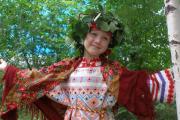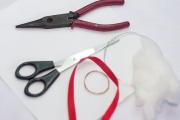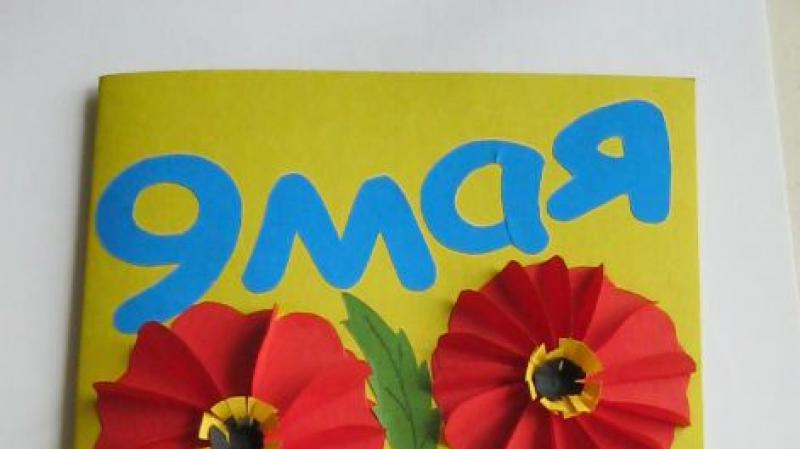How to make nail extension with tips. How to build nails on tips with gel at home
Currently there are different kinds manicure that can make any fingers well-groomed and beautiful.
Lovers of long nails are often faced with the problem of making such a manicure on their nails. Extension of nails will solve this problem by offering various options. The easiest of them to do it yourself is to build on tips. To perform this procedure at home, you need to know how to properly extend nails with gel on tips.
Tips are represented by forms of plastic, which are glued to natural nails and covered with a layer of gel on top. They differ in shape, quality, price. When choosing tips, you need to pay attention to the material from which they are made. They should not have harmful components that, entering into a chemical reaction with the nail plate or the skin of the fingers, can be harmful to health.
Thick and heavy tips break faster and look unnatural. To achieve a good result, it is not necessary to choose the most expensive ones, you just need to carefully study the information about those that are available.
The most famous materials for tips are:
- ABS plastic;
- nylon;
- polyflex.
The main purpose of nail extension on tips is to bring the result closer to natural nails.
How to properly extend nails with gel on tips for a natural look:
- The plastic from which the tips are made must be thin and elastic.
- Select the shape and size of the tips as accurately as possible to the size of your own nails.
- For flat or convex nails, use special tip shapes.
- For wavy nails you need to choose the right glue for the tips (usually in these cases, a glue-gel is used that fills in the irregularities).
The procedure for building on tips will not only lengthen the nails, but also smooth out their irregularities, hide small defects. It is easy to execute and with due diligence, a good result can be the first time.
The technique of nail extension with gel on tips will require the following tools and means:
- cuticle softener;
- cuticle stick or pusher;
- file or buff (polisher) for nails;
- tips;
- tips cutter;
- special glue;
- special napkins (lint-free);
- gel;
- brush for processing nails after filing;
- brushes;
- a means for removing the sticky layer;
- primer;
- degreasing agent;
- cuticle oil.
Step-by-step guide to nail extension with gel on tips
 Despite the seeming ease of nail extension on tips, the procedure requires certain knowledge and skill.
Despite the seeming ease of nail extension on tips, the procedure requires certain knowledge and skill.
For a better understanding of its implementation, you need to visit a salon and watch how a professional makes a step-by-step extension of nails with gel on tips.
After the procedure for building nails on tips has been studied, purchases should be made for its implementation. To this end, you will need to buy a set for nail extension at home.
To purchase tips and tools for working with them additionally, if they are not in the set.
Independent step-by-step gel nail extension on tips:
- Prepare the workplace, tools and equipment for work... Select tips, lay them out in the order of gluing in accordance with the nails. Tips should not exceed 2/3 of the natural nail at the gluing point. The excess must be carefully cut off. You cannot glue the tips that are narrower than the nail. It is better to choose the one that is wider and with a file, carefully cut down its width, adjusting it to the size of a natural nail.
- Wash hands with soap or an antiseptic... Remove excess cuticle especially carefully, as the remaining pieces of skin can further lead to the detachment of the gel. Cut off the free part of the nail to 0.5 millimeter, file with a file. Use a buff or a file to remove the shiny surface from the nail plate. Clean it with a brush.
- Apply glue to the tips up to the step line, which, when glued, is applied to the edge of the nail... For better adhesion, you can apply glue to the nail in the area of connection with the tips. Attach the tips to the middle of the nail at a slight angle and press down on the rest. The line of the step should line up with the edge of the nail. Hold for 15 seconds for gluing. If bubbles appear between the tips and the nail, try to squeeze them out or re-glue the tips.
- After the tips are glued, they are processed to the final shape.... Using a tip cutter (cutter), cut off the excess length, giving the nail the chosen shape. Saw off the tips with coarse-mesh saws for alignment. Use a buff or the same file to clean the surface of the tips for better adhesion to the gel. Particular attention should be paid to the junction of the tips and your nail. Use a file to clean this place as thin as possible so that the transition is invisible. Brush off dust from nails and finger skin. Treat nails with a degreasing solution, apply primer and dry.
- Get started with gel... Apply the first thin layer. It is necessary to retreat from the cuticle and lateral ridges about a millimeter. Dry with UV lamp for 2-3 minutes. Apply the next layer, denser, to the middle of the nail, gradually reducing it to the sides. Drying nails in the second stage for at least 3 minutes. If you feel pain from heating the nail, you can take a break and then continue drying. When drying is interrupted, it is necessary to turn the nail down so that the unformed gel layer does not spread. After drying, the sticky layer is removed with a special tool.
- When all the marigolds are covered with the main layer of gel, it is necessary to give them their final shape.... Using a file or buff, you need to process the surface of the nail, removing the unevenness of the arch. Clean the sides and nail area near the cuticle, minimizing the coating as much as possible. File the tips of the nails so that they are as thin as natural nails. Treat unevenness on the free edge. Brush off dust.
- At the final stage, a final gel coat is applied.... It should lie on the nail with a thin, even layer. In the last coating, the previously left places along the lateral ridges and cuticles are also used. Dry in a UV lamp. Some manufacturers produce a topcoat that does not have a sticky layer. If there is such a layer, then remove it. The marigolds are ready. At the end of the procedure, rub the oil into the cuticle.
Nail modeling with tips is one of the ways to build up artificial plates. It allows you to make the dream of many come true modern women who want to have beautiful and elongated nails. And if the building process for someone seems too complicated and overwhelming for independent implementation at home, it is worth dispelling this myth and dwelling in detail on the main nuances of building.
Features of technology
Nail extension with tips is a painless and safe procedure. Of all the known extension technologies, the option using special plastic blanks is the simpler. To master this workflow is quite within the power of every woman, while for the first time the whole procedure will take no more than a few hours, taking into account the fact that imperfect marigolds will have to be lengthened.
Working with tips can be designed for a contact or non-contact area. Such zones differ in size: they are small, large, deep, shallow. You have to work with the option that is more suitable than others for the individual characteristics of natural nail plates. For example, in the case of a short nail bed and a large downward bend, you will have to work with the option that has the smallest contact area.




However, experienced craftsmen today have gotten used to working with tips that have any contact zones, so it is not at all difficult for them to cut out the desired shape. For this reason, among the kits of the master, there are often not all varieties: they can simply lie idle. Although in fairness it is worth noting that the craftsmen still have options that do not need cutting out, because they are very convenient to work with and do not allow you to distort the correct shape.
This technique is somewhat different from nail extension through forms. It is used when natural nails are too narrow or short. This is an excellent option for saving the situation of transforming the nails of "rodents", because it is unrealistic to build up nail plates that are bitten to the root. They also work in this technique when their shape is far from the desired ideal, as well as the sides of the plate are very uncomfortable.




Tips in translation mean "tip". These are plastic blanks in the shape of a nail, which differ in size and shape. In fact, these are a kind of templates that will give the desired shape to the modeling tool in the process of increasing the length. They will also correct the convexity of the nail plate, preventing the effect of a pecking nail and an overly large bulge.


By appointment
It is a mistake to assume that all tips are the same. In fact, they can differ in color and purpose, because they are selected in accordance with what the final method of manicure will be. Transparent options and templates natural color are intended for building up and further overlapping the created base with gel polish. If a French design is planned, they differ in thickness. They are thinner than other varieties.

And also in the line there are varieties with a colored background and a ready-made design. These are, in fact, ready-made solutions, although, if desired, the former can be decorated with some kind of print, and the latter can be simply coated with transparent varnish. In addition, the options can be versatile, with ample bend and large bend. The bending of the frame is necessary in order for the extended nails to look beautiful and natural.




By form
The shape of modern tips is variable. On the shelves of brands you can find different variants for every taste. Today there are 5 varieties of the tips form.
- In the classic version, these are blanks with a natural and smooth bending shape. As a rule, they are sold in sets with a democratic cost. Such varieties are often used by professionals of the nail service, performing nail extensions for clients.
- Other options include straight tips that do not have a contract zone. For this feature, they are called contactless, they are extremely convenient for performing a jacket. Such varieties are also inexpensive, and it will not be difficult to buy them today. On average, a pack of one hundred pieces will cost 150 rubles.
- When it is necessary to create a special narrowed shape, tips of the narrowed type acquire. They can be used in the work of building and shaping the stylet, bridgette forms and cat nails.
- Many people want to make an "American" uniform. In this case, it is necessary to buy folded tips.
- The last variety is the almond shape tips. These products allow you to build up the correct almond shape in a short time. They are characterized different lengths, may or may not have a contact area. Their cost is about the same as the cost of blanks for a stiletto (about 150 rubles for 50 pieces).

Important! In general, any of the options may differ in length, which is usually indicated on the packaging. Craftsmen usually purchase long frames that allow them not to limit the desired level of length.
By materials of manufacture
Tips for nail extension are made of different materials. For example, one of the most popular solutions today is the so-called liquid varieties. These are reusable options that are made from special polymer raw materials and are characterized by a flexible structure. For beginners, this is the most convenient and easiest way to extend nails. It does not require a large number of tools and materials, although it does not do without a special drying lamp, which is usually used when working with gel polish and gel.




Tips are made from plastic, nylon and polyflex. Each type of material has its own nuances. For example, plastic products are considered to be quite durable and preferable to work with. Plastic is resistant to temperature, it is easy to wash, it is convenient in the process of building. If you need to build up your nails with gel, then it is better to choose options from the polyflex. Such solutions are quite elastic, they are resistant to the effects of acetone. As for the nylon varieties, they are not suitable for beginners, as they can be problematic in fixing, while it is worth noting that nylon holds its shape well.



How to choose?
It is not difficult for an inexperienced woman to get lost in the sea of offers that various trade marks shower customers with. However, there are several nuances that you can pay attention to when buying tips.
- The absence of sharp edges minimizes the risk of injury at work. It is important that the inside of the elements does not have any nicks, roughness or even scratches. This is an obvious marriage that will ruin the whole work. During the formation of extended nails, a marriage of the coating will be created, which is far from always able to be corrected by sawing out.
- It is impossible not to take into account the thickness of the tips, as well as their strength. To get really good products, you need to choose from a number of thin and elastic. A good option will bend and take its original shape. In the case of choosing a variety with a ready-made design, you need to understand that the greater the thickness of the material, the worse it will look on a woman's hands.
- Tips are not the material to save on. Therefore, preference when buying should be given to manufacturers with a good reputation for nail service professionals.
- If at the time of purchase it was still possible to make a fitting, then we would definitely acquire the ideal types of frames. To find your own version that would ideally fit on the natural shape of the nail plate and thereby simplify the process of building up, you should pay attention to the size. It is better that the frame is slightly larger than the nail, since the small template simply will not come in handy.
- It is possible to purchase sets with a large number of tips. Among them, it is easier to choose options that are better suited to the characteristics of specific nail plates.

Required tools and materials
Everything you need that may be needed to build nails on tips will come from what kind of frames and materials are used. It is worth noting that the process is performed with gel or acrylate. A drying lamp is needed precisely for the first material, since it will not dry without it. The device can be UV, LED or combined. In addition to the lamp, you will also have to use a brush.

As for the acrylic extension technique, here you will have to work faster, while trying to avoid mistakes. The acrylate will dry on its own without any help. In general, in the work, you may need tips themselves, and of different sizes, special glue for such frames, a tips cutter device. You cannot do without an antiseptic agent, which will have to treat your hands. In addition, you should take care of the presence of a file with an abrasive of 180/100 grit, lint-free napkins, alcohol, a brush for removing dust, cuticle oil.

Preparing for the process
Regardless of whether it is planned to use gel or acrylic during nail extension, without high-quality preparation of the nail plates, the further work process will become impossible. In fact, the preparation will be a hygienic manicure. First, you must use an antiseptic. To simplify, reduce the soreness and trauma of the procedure, a special cuticle remover can be applied to the skin around the nails. In the future, it will contribute to the painless removal of excess skin. Sometimes it is first necessary to remove extended nails, someone has to remove the pigmented coating.




It is important to completely clean the surface of the nails, because the quality of adhesion with the modeling agent, as well as the durability of the extended plates, will depend on this.
After the cuticle and pterygium are removed, an orange stick is passed along the contour of the plates, checking with its help the quality of cleaning. Then they begin to remove the shiny layer of nails. This is necessary in order to increase traction when passing over the surface with a soft grinder. After getting rid of the gloss, dust is brushed off the nails, then they are degreased. On this, the preparation can be considered completed.

Extension technology
How to use nail tips at home will depend on the type of product used. In general, the technique cannot be called complex and requires any special knowledge with a deep study of them. Following the detailed step by step instructions for novice masters, nail extension itself will not take much time, although the process will require accuracy and perseverance. The technique will be based on the type of material used.


Gel
The work uses a UV lamp. The good thing about this technique is that it saves a lot of time and money. So, one set of tips is enough for about 2 years. If desired, the buyer can purchase a set, which, in addition to the blanks, includes the gel itself.
The phased execution of the workflow in this case will consist of the following sequential steps:
- after degreasing the nail, a primer adhesion material (primer) is applied to it;
- choose the template that is most suitable for the size of the nail, trying it on and determining the size, using the markings of the form itself;




- they collect a little gel and place it with a brush into the inside of the tips;
- the modeling agent is distributed over the size of the nail and stretched in length, while the material should continue the growth line of the nail;

- the form is glued together with the gel to the extended nail, pressing tightly;
- the nail is placed in a lamp to dry;
- after the required time (2-3 minutes) has elapsed, the tips are removed;

- a little more funds are applied to the base layer of the gel, forming a stress zone; camouflage can be used;
- the nail is dried in a lamp for 3 minutes, then the dispersion layer is removed and the end is given the required shape;
- apply top-gel without a sticky layer, dry it in the device for several minutes.

This method is convenient in that it is quite convenient to substitute the tips to your nails. In addition, there is no need to glue the nails themselves, cut the material to achieve the desired length. However, in order to fully understand the essence of the process, it is worth watching the video material, which will greatly simplify the work with the gel. The fact is that the gel may not flow properly. And also in the work you may need a turning lamp.


Acrylic
Acrylatic is considered a quick-drying agent. It allows you to get a high quality result without a lamp. Such marigolds are distinguished by their natural appearance and thickness, as well as elasticity. When working with acrylic, it is advisable to ventilate the room, since the material has a specific smell. In addition to tips, you may need nippers and a special agent for dissolving acrylic. In addition, it is advisable to stock up on a small container for dissolving acrylic.



After treating your hands with an antiseptic (alcohol), they perform a hygienic manicure. After going through all its stages and properly preparing the nails, select the correct size tips for each of their plates. At the same time, make sure that the contact area covers less than half of the area of the plates. If the preparation of the tips themselves is necessary, then they are laid out in order, depending on the options chosen, and the edges of the contact zones are cut down.
- degrease the nail, apply glue to the contact area and distribute it with a brush; make sure that it does not spread, so they hold the tips at an angle of 45 degrees;
- the template is applied to the nail in such a way that it touches the regrown edge of its nail;
- the workpiece is pressed against the nail and held until it grabs;




- the frame is given the desired shape, after which it is buffed and primed;
- acrylic powder is combined with a monomer, forming a creamy mass, a small ball is collected and distributed on the nail;
- form a cylinder of a transverse arch, giving the nail a bulge;
- the excess thickness is removed with a file, a fixer is applied to the surface.




Design ideas
You can perform manicure on extended nails in different techniques... One of the best solutions would be a jacket, whether traditional or reverse. You can combine the colors of the stackable materials, thereby creating a ready-made design immediately. If you do not like this option, you can turn to various techniques for decorating nails. For example, you can paint the nails with matte varnish, and draw lace motifs on the accents with a glossy material of the same color. The play of textures always fascinates the eye, such a design is in trend today.




If you want something different, you can change the texture of classic manicure coatings. An excellent solution for this will be acrylic powders and rubbing. At the same time, powders can not only cover the entire area of extended marigolds: they are good for creating voluminous curls, monograms, lace, flowers. As for the rub, they look great on elongated marigolds of the "May beetle", "mermaid" and "holographic" varieties.


And you can also highlight the accents of your manicure using hand-painted in a variety of themes and techniques, including watercolors, stained glass, and bleed effects. When choosing the option, the watercolor substrate created by the base, pigment and top is buffed so that it is rough. After that, on the working background, they paint with artistic watercolors on water based... And also for this technique are good and acrylic paints, which are diluted to the desired consistency with top.




On extended nails, Yuki's glitter looks great, which is a kind of rubbing in the form of flakes. Today it is one of the hits of modern design that allows you to give your nails a unique texture. It is very popular to decorate artificial nails with a dot pattern, which is created using dots with different attachments. It can be various ornaments, in this way they paint a French smile. Sometimes the extension is performed with a variety of glitters, mixing the modeling gel with different glitter. For more shine, you can use two shimmer layers in the work.



It is worth adhering to the following tips from professionals:
- for nails to look beautiful and well-groomed longer, you need to monitor the condition of the skin, not forgetting to moisturize your hands with cream;
- it is advisable to protect them from frequent steaming and the use of household chemicals, since this will fade and darken the applied coating;
- in order to avoid peeling, it is preferable to use rubber gloves when washing dishes;
- you should not expose your nails to stress, avoiding a sharp temperature drop, since this can cause the extended nails to become covered with cracks;
- if it becomes necessary to remove the applied coating, you need to use a product without acetone;
- do not expose your nails to injury by knocking them on hard surfaces;
- as for the correction, it can be carried out no earlier than two weeks after the completion of the build-up; you can correct the shape after three weeks, although artificial nails cannot be over-worn.

Many tools allow you to do this yourself at home, but there are some nuances, we will try to take them into account so that the work looks natural and effective. Let's consider two ways how to build up nails at home using tips and gel polish.
How to properly build nails on "tips"?
T ips are a special material for lengthening nails. Every girl in childhood necessarily had "false" nails, which she put on her relatives, and got long marigolds.
Nail tips are a descendant of such false nails. Only they are not superimposed on the entire nail, but continue it from the widest point of the plate.
How to choose the right tips for your nails:
- Choose thin tips. Tipsa material should be as close as possible to your nail plate, that is, the same thickness as the nail, and the same elastic;
- Select the material in size more accurately to the size of your nails, otherwise the look of naturalness will be lost;
- The shape of the nails is also important when choosing tips. If your nails are too flat or bulging, choose tips specifically for that nail shape.
To build up nails at home in stages, it is worth taking not an ordinary decorative gel polish, but the following consumables and tools:

- A special UV lamp that allows gel polish to cure much better and faster.
- Special gel for building.
- Tips and tips cutter.
- Glue, brush, nail file with surfaces of different abrasiveness.
- Degreasing compound.
How to build nails correctly: tips + gel
- Prepare your hands. Wash them thoroughly with soap and an antiseptic. Too greasy or dirty nails will not allow the extension glue to dry, and you will only waste material;
- Now apply a little glue to the tips in the place where it will be applied to the nail;
- After the tips have stuck, you can start processing it and bringing it to the shape of the nail you need;
- Apply the base layer of the gel to the resulting nail and cure with a UV lamp. Apply the gel according to the rules so that it lies in an even thin layer;
- After the gel has dried, give the nail the desired shape and remove irregularities from the surface with a file;
- Now you can cover the resulting nails with a tonal varnish, and then with a top.

How to build nails correctly: video instruction
How to build nails correctly: with gel polish on the form, video tutorial
The extended nails are ready! As you can see, the whole process is very easy and simple, and requires very little experience with the extension tools.
Now you can do the most Beautiful design manicure, look!
Most girls regularly extend their nails. The fashion for this type of manicure persists for a long period of time. With such nails, your hands always look well-groomed, and the varnish lasts much longer. However, it should be understood that such nails require regular correction. Once every 2 weeks, you must regularly visit the salon to correct the nails. This process takes not only too much time, but also a decent amount of money, so more and more girls began to wonder whether it is possible to grow marigolds while at home?
Any girl can perform such marigolds on her own. To date, a huge number of video lessons are presented on the Internet, which clearly show all the nuances of building up on tips in step-by-step instructions.

Tips - what is it?
The word tipsy comes from the English word tip, which means tip. They are presented as natural nails designed to lengthen their marigolds. Tips exist of various shapes and lengths, so each girl independently selects not only the length of the artificial nail, but also its shape. Tips can be purchased in a special set.
Make sure that the tips are not small for the nail.
All tips are divided into 2 parts, one part is the shortest, because it is applied directly to the nail itself. The second part is a free edge, which you can arrange as you wish.
Tips can be made of transparent and white material. To date, on sale you can also find a color version, on which a drawing has already been applied. In addition, there are nails according to the degree of curvature.


Acrylic is the material used to create long nails. Even in the distant 60s, dentists used this material for dentures. However, a little later, one of the dentists pleased his wife with artificial acrylic nails.
Over time, acrylic began to be actively used for nail extension. The main difference between this type of extension is that you do not need to use a UV lamp for this technology. This material dries in air in 2-3 seconds.


Instruments
In order to perform acrylic build-up, you need to prepare a number of tools that will come in handy:
- Acrylic (one color should be used for beginners);
- Primer;
- Monomer, the volume of which should not be less than 50 ml;
- Nail tips (set of 100 or 50 pieces). A large number is needed in order to pick up tips by size;
- Brush for applying acrylic;
- Tip cutter. This is a tool with which it is possible to cut off the excess part of the material without damaging the nail itself;
- File for the nail plate, the abrasiveness of which is 100x180 grit;
- Buff used to polish nails;
- Napkins that should not leave lint on the nail plate;
- Alcohol;
- The cup used for the monomer (it must be with a lid);
- A brush to remove dust;
- Glue (you can use both special and ordinary);
- The oil used for the cuticle.


Consider the process of nail extension on tips and step-by-step instructions.
Process of creation
- Treat the handles with an antiseptic. This step will allow not only to degrease the marigolds, but also to remove germs;
- Apply a special product to soften the cuticle. After that, it should be pushed aside with a wooden stick. Prepare the nail with a coarse file. The rougher the surface of the nail plate, the better the adhesion of the tips with the real nail will occur. You should lightly press the nail against the natural nail plate, because with strong pressure on the nail file, the nails can be deformed;
- It is extremely important to choose the right tips for the width of each nail. If it is possible to adjust the length, then the width cannot be adjusted. In addition, tips should be handled correctly. To do this, the part that is glued to the nail bed must be cut down and scraped out from the inside;
- It is necessary to glue artificial marigolds. The glue should be applied to the prepared part of the nail at an angle of at least 45 °. After applying to the nail, the tips are held for a few seconds, pressing it;
- Correct the shape and length using a tip cutter and a nail file for this;
- Next, a primer is applied to the nail plate, which degreases the nail. Make sure that the liquid does not get on the cuticle, and also do not disinfect all nails at once, because the effect will not last long;
- Mix the special compound and acrylic powder. Watch the ratio of the ingredients. The consistency should turn out to be plastic, but you should not pour too much powder, otherwise yellowness may appear;
- Apply acrylic to the nail plate, spreading it over the entire nail very quickly. The acrylic ball is distributed using a brush. To create a jacket, you should use not transparent acrylic, but pink and white, which is used to draw a smile;
- Excess thickness is removed with a nail file. Processing starts from the side of the nail, moving to the center. After that, a small nail file is taken and the surface of the nail plate is processed, completing its correction;
- Give the nails smoothness. For this, a buff is most often used. All tools should be wielded in one direction only, without pressing hard on them.
- The procedure is completed by applying the fixer. If it is not there, then a base for a manicure is applied to the nail.


After the completion of the procedure, a nail design is created at will. The process of building marigolds with acrylic on tips is the easiest way to lengthen marigolds. However, this method is not suitable for everyone: acrylic smells unpleasant, resembling a dental office. If some are stopped by this factor to create beauty on the nails, then others are happy to make such sacrifices.
Many girls are convinced that building with gel is much easier than with acrylic. And there really is some truth in this. Acrylic dries very quickly in air, so all steps must be done quickly, while gel modeling can be done slowly. Therefore, it is better not to tackle acrylic build-up without a full hand. With gel extensions, a number of rules must also be followed. For example, the drying time should be calculated correctly because dry or not dry, you run the risk of being left without durable material.


Instruments
To create gel extensions, you should use a whole set of tools:
- Glue;
- Primer;
- Directly the gel itself;
- Tip cutter;
- UV lamp, which is required to dry the gel layer;
- Brushes for applying gel;
- Various nail files;
- Cotton pads that do not leave lint;
- A product designed to soften the cuticle;
- Orange stick, which is used to push back the cuticle;
- The liquid with which the marigolds are degreased;
- Oil for nourishing the cuticle;
- Liquid for cleaning brushes;
- Antiseptic;
- A product designed to remove the sticky layer.


Process of creation
- Preparation of nails (manicure and disinfection). Finally, apply a primer;
- Stick the nail tips on the nails. Give the desired shape and produce sawdust;
- Apply the gel to the nail, leaving a little space from the cuticle. After distributing the gel over the entire surface of the nail plate, dry it in a UV lamp;
- Carry out the procedure for applying the gel 2-3 times for the greatest strength;
- To make sawdust of the finished nail, leveling its surface. It is not required to polish the marigolds, because one of the main advantages of such a build-up is the natural shine of the gel without much manipulation.
- At the end, a design is thought out, which is carried out on finished marigolds.


Here are all the secrets of building on tips. It will take 3-4 hours of free time to complete the manicure. The first nail correction should be performed 2 weeks after the procedure. Subsequent correction procedures are carried out no earlier than 1 month after the procedure.
Almost every woman dreams of beautiful and long nails. However, a lack of vitamins, washing dishes and many other factors prevent it from growing the desired length. Fortunately, there is such a procedure as nail extension, which allows every woman to become the owner of beautiful and well-groomed nails. What types of this procedure are and what are their differences, this article will tell.
Extension types
Currently, such a procedure as nail extension has become commonplace for most women, because it allows you to forget about manicure for about 1 month. However, before going to the procedure, it is advisable to familiarize yourself with all its types in advance in order to choose the most suitable method for yourself.
There are two main ways to build up:
- on tips;
- on forms.
Let's consider each in more detail.
Tips
Nail tips are plastic plates that attach to the nail at one end, and form its free edge with the other. They are glued to about half of the area of the nail plate. The length of the free edge should not exceed the area of the glued tip, otherwise the nail may break in the future.
The most durable tips are made of special ABS plastic. Such material is not afraid high temperatures and aggressive detergents.
Plastic can be the most different color(transparent, milky, etc.), length, bend, which allows you to choose the ideal option for a wide variety of nail plate.
Plastic is attached to a natural nail with special glue, after which it is given the required length using a special tool - a tip cutter (cutter). Next, the surface of the nail plate is leveled with a file (the border of contact of the nail with the tips is removed), and it is given a shape. Finally, the plastic is fixed to the nail using gel or acrylic.
It is worth remembering that the specialist removes the length of the tips with a small margin, since after laying out the gel or acrylic, additional sawing and the formation of the required shape will take place.
With a high-quality extension, such nails last from 3 to 4 weeks.
Forms
They are disposable paper or foil products, with which the free edge of the nail is formed. The outer side of the paper is covered with a special layer that prevents the extension material from sticking to it. The other side of the product is sticky, which allows it to be securely attached to the finger.
In addition to disposable forms, there are also reusable options that are made of metal and fixed with special clips. Such a variety must undergo a sterilization process before each new use.
The shape is fixed on the finger, substituting a special window under the free edge of the nail. After the form is fixed on the nail, its free edge is formed with the help of gel or acrylic. There are special markings on the product that characterize the future length, you just have to choose the one you need. After choosing the length, the master lays out the material for building on top of the form, reaching the required border. Further, after the substance has hardened and the nail plate is formed, the form is removed.
The disadvantage of this method is that a natural nail must have a small free edge, at least 1-2 mm, otherwise the shape simply will not hold. Therefore, nail tips are more suitable for short-cut nails.
After the formation of the free edge and the nail bed, the forms are removed and discarded. The tips remain for the entire time the socks of the nails until they are corrected or completely removed.
Extension material
If we consider the build-up by the material used, then it is divided into two main types: helium and acrylic.
The main differences are that acrylic dries in the open air, while the gel requires drying in a special lamp.
Let's consider each material in a little more detail.
Gel
It is a thick, jelly-like substance.
There are 2 types of gel:
- Single phase. This type of material assumes that in one jar there will be 3 types of gel at once to create different layers (basic, modeling, protective). This option is ideal for beginners.
- Three-phase. This type consists of 3 gels in different jars. The three-phase gel is more often used by professionals, since it guarantees a better and more reliable build-up.
The main advantages of nail modeling with gel include:
- appearance. Nails look natural, they shine and do not turn yellow;
- lack of unpleasant odor;
- ease of use. The material is able to spread itself over the nail plate, it does not dry out in the air, so you can work with it longer, carefully shaping each nail. In addition, this material is easier to cut and shape;
- ease of correction. During corrective actions, it is not necessary to cut off the entire surface of the gel, it is enough just to saw down the overgrown or peeling parts.
However, in addition to the advantages, the gel also has disadvantages:
- firstly, for this modeling method, a special lamp is used, the ultraviolet rays of which can lead to premature aging skin;
- secondly, a material such as gel is less durable. For example, with a strong temperature drop, the surface of the nail may crack;
- thirdly, in order to completely remove the gel, you have to use the cutting technique, which thinns the nail plate. In addition, dust generated during sawing can be harmful to health if inhaled. That is why, when working, you should wear masks, gloves and use a hood.

Acrylic
Acrylic is a material for nail modeling, which consists of powder and monomer. A liquid substance is added to the powder, as a result of which it acquires a state of gruel. This mixture freezes in air. Surface hardening occurs quickly (within a few minutes), however, complete cure is achieved after 24 or even 48 hours. That is why, when building up with acrylic on the first day, physical impact on the nails should be avoided.
This material also has a number of advantages and disadvantages.
The pluses of acrylic include:
- strength. This material is more durable;
- just shoot. To remove material from the nail, it is not cut down like a gel, but dissolved with a special solution;
- it can be used to make beautiful decorative elements on the nail.
The disadvantages of this method include the following points:
- a possible allergic reaction and bad smell... Often a person is allergic to acrylic, and not everyone likes its smell;
- less natural look. When extended with acrylic, the nails do not look so natural, their surface will be matte and may turn slightly yellow over time;
- dries quickly in the air, so you need to work with it very quickly.
In addition, acrylic is considered more harmful to the body than gel. When choosing acrylic extensions, be sure to pay attention to the composition. A substance like methyl methacrylate is very toxic. That is why you should choose products containing ethyl methacrylate, which is less harmful.
other methods
In addition to acrylic and helium extensions, there is a combined method that combines all the best qualities of each of the types. This variety allows you to get durable and shiny nails.
The master can perform combined extensions in several ways:
- The base coat is made with acrylic. Next, a gel is applied on top of it to make the nail plate shine.
- The basis of the nail is a gel, on top of which acrylic is applied. In this case, acrylic is used to create decorative elements (flowers, etc.).
- The specialist uses a correction acrylic nails using a gel.
- The master alternates materials.
Another type of extension is silk. In this form, fabric is used: fiberglass, linen or silk. These materials are pre-soaked in a special solution that makes the fabric hard. Silk extensions help preserve nail health and make them more beautiful. However, this method is less popular.
There is also biogel build-up, the composition of which is more natural. Among the components of biogel there are useful substances (proteins, vitamins, etc.). This material allows the nail plate to breathe, it is safe and elastic. With its help, not only nail extension is carried out, but also the strengthening of the natural nail plate. The undoubted advantage of biogel is that it is removed not by sawing, but with the help of a special liquid, thereby excluding mechanical damage to the natural nail. The downside of this build-up is its fragility.
The main stages of building
To roughly imagine how the procedure goes, consider the main stages of its implementation.
Gel
The main stages of building on forms:
- Disinfection, filing natural nails and shifting the cuticle (if not done before) using an orange stick or a pusher. If you do not carry out such a treatment, then when the nail grows back, the gel will move away precisely at the points of contact of the material with the cuticle.
- Removing gloss. Using a coarse file (about 180 grit abrasiveness), remove the shine from the nail plate and roughen it. The most important thing is not to overdo it, otherwise you can ruin the nail plate.
- Removing dust and treating the nail with an antiseptic.
- Further, the forms are substituted under the nail, and its surface is treated with a primer (improves the adhesion of the gel to the nail plate).
- After that, a thin layer of gel is applied to a natural nail plate and dried in a lamp. The exposure time depends on the gel itself and the lamp power.
- Then, without removing the sticky layer, using the gel, they form the free edge of the nail, going slightly onto the natural nail plate, and dry it in a lamp.
- Then a third layer is applied more densely, which is also dried in a lamp. With the help of a modeling layer, a bend is formed, and the nail is also fastened to a free edge.
- Then the mold is removed, the sticky layer is removed and the nail is formed. It is filed, leveled, its surface is sanded with a buff, and dust is removed with a brush.
- When the nail is fully formed, it is degreased and designed.
- At the end, the finish is applied in a thin layer, the free edge is sealed, after which the nail is dried in a lamp. To soften the cuticle, it is treated with a special oil.
If a three-phase gel is used, then each new layer (base, modeling, finishing) should be collected from a different jar.
During the application of the gel, it is necessary to ensure that it does not come into contact with the skin and nail rollers, otherwise the material will subsequently begin to flake off.
Acrylic
If acrylic is used, then the stages of building are as follows:
- Processing of nails before extension is the same as with the helium method of modeling.
- After treating the nail with a primer, the master dilutes the acrylic powder with a monomer and draws an acrylic ball onto the brush.
- After that, he transfers the ball to the nail, evenly distributing it over the entire plate using the patting movements of the brush.
- If molds are used, the specialist begins to apply the acrylic from the free edge of the nail, starting to align the acrylic ball from the marked length down to the nail itself. Wipe the brush thoroughly after each ball of acrylic mixture is applied.
- As soon as the free edge has been formed, the master proceeds to lay out the nail bed, necessarily stepping back from the nail rollers and cuticles.
- Before the material hardens, it is bent.
- As soon as the acrylic hardens, the molds are removed and the nails are straightened, designed and shine.
These are just the main stages of building, without mentioning most of the nuances.

In order for the nails to delight their owner with beauty as long as possible, you should remember a few simple rules:
- It is best to go to the procedure with the cuticle removed in advance. That is why you should carry out a manicure 2-3 days before building.
- On the day of the procedure, you must refuse to take a bath, as well as use for hands. Moisture and grease that remains on the nail plate is difficult to remove even with the help of special products. If the surface is not completely degreased, this will affect the build quality.
- In order not to aggravate the condition of the nails, do not build on a too thin or damaged nail plate.
- Refuse the procedure for the entire time of taking or antibiotics, which can affect the duration of wearing nails. Chemotherapy is also a contraindication to building up.
- It should be borne in mind that the quality and duration of socks artificial nails some diseases can affect, as well as hormonal disruptions (during pregnancy, menopause, etc.).
- Always use gloves when washing dishes or working with other household chemicals.
- In the absence of building skills, you should not remove or saw off your nails on your own, all actions are best carried out by an experienced master.
- Treat the periungual ridges and cuticles with a special oil, and take care of your hands with creams containing vitamin E.
- To minimize the damage from buildup, it is recommended to take breaks from time to time and at this time resort to restorative procedures on the nail plate.
Beautiful nails will adorn absolutely any woman and make the image truly complete. The most important thing is to choose the most suitable option procedures, as well as refer only to experienced craftsmen, comply with all its recommendations and carry out correction in a timely manner. And then the nails will always delight you with their beauty and impeccable appearance.














